Social Isolation in Personality Disorders
Unveiling the Links Between Loneliness and Personality Disorders

Introduction
Life is inherently social, with our personalities shaping the ways we interact with the world. However, for individuals with personality disorders, social isolation can become a formidable adversary to their mental well-being and recovery. Personality disorders are often marked by enduring difficulties in personal and social contexts, leading to intense feelings of loneliness and disconnectedness. This article explores the complex interplay between personality disorders and social isolation, while delving into contributing factors, impacts, and interventions that aim to mitigate these profound challenges.
The Complex Interplay of Personality Disorders and Social Isolation
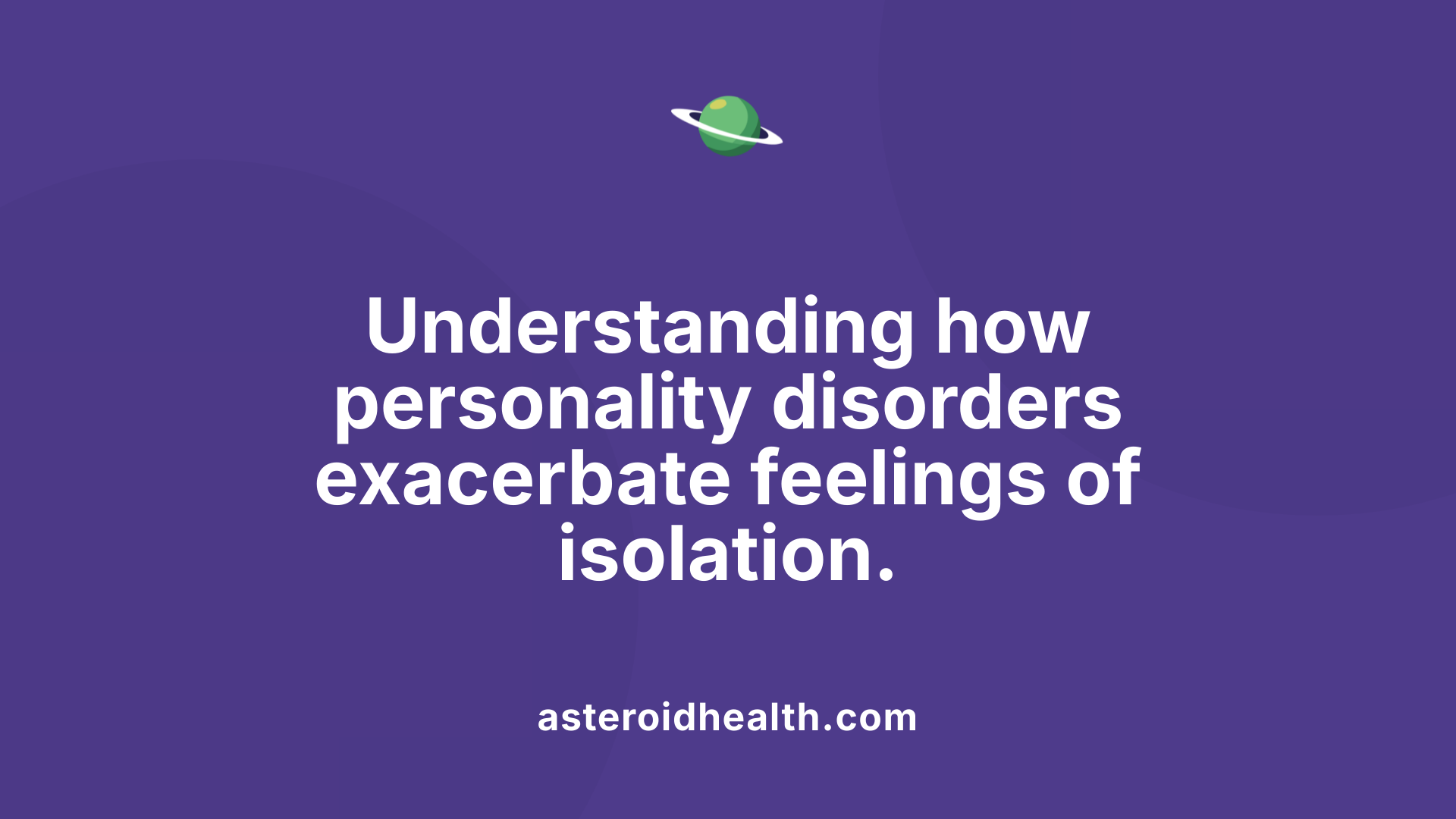
What is the relationship between social isolation and various personality disorders?
Social isolation is commonly observed in individuals with certain personality disorders such as schizoid, avoidant, and borderline personality disorders. These conditions can lead to difficulties in social interactions, resulting in isolation.
Schizoid Personality Disorder (SzPD)
Individuals with SzPD generally prefer solitude and maintain very few close relationships.
- Emotional expressiveness: Often perceived as distant or cold, they experience discomfort with emotional intimacy.
- Social connection: Even though they may assert that they enjoy being alone, this can stem from challenges in interpersonal interactions.
Borderline Personality Disorder (BPD)
BPD is marked by a profound fear of abandonment and unstable relationships, contributing significantly to social isolation.
- High loneliness: Studies have shown people with BPD report higher levels of loneliness compared to healthy controls, with mean loneliness scores significantly higher (60.17 vs. 31.39).
- Chronic feelings of emptiness: Patients often experience mood swings and intermittent engagement with social situations, further complicating their ability to maintain relationships.
Avoidant Personality Disorder (AVPD)
AVPD is characterized by an intense fear of rejection and feelings of inadequacy, propelling individuals into isolation.
- Social avoidance: Those with AVPD often evade social interactions, preferring isolation to the risk of being judged or criticized.
- Co-occurring disorders: Conditions like depression and anxiety frequently accompany AVPD, exacerbating feelings of loneliness.
Narcissistic Personality Disorder (NPD)
While individuals with NPD may engage socially for self-serving purposes, they can also exhibit isolating behaviors.
- Manipulative social engagement: They seek social interactions that reinforce their self-image but withdraw when interactions do not meet their needs.
- Contradictory to acceptance: This behavior results in superficial connections, fostering loneliness despite outward appearances of sociability.
| Personality Disorder | Key Features | Impact on Social Isolation |
|---|---|---|
| Schizoid PD | Preference for solitude, emotional detachment | Limited close relationships |
| Borderline PD | Fear of abandonment, unstable relationships | Higher levels of loneliness |
| Avoidant PD | Fear of rejection, feelings of inadequacy | Increased social avoidance |
| Narcissistic PD | Self-serving social engagement, withdrawal | Superficial connections, loneliness |
Understanding these complexities highlights the significant mental health implications of loneliness in individuals with personality disorders and the necessity for targeted therapeutic approaches to foster social connections.
Childhood Trauma and Its Pervasive Impact on Loneliness
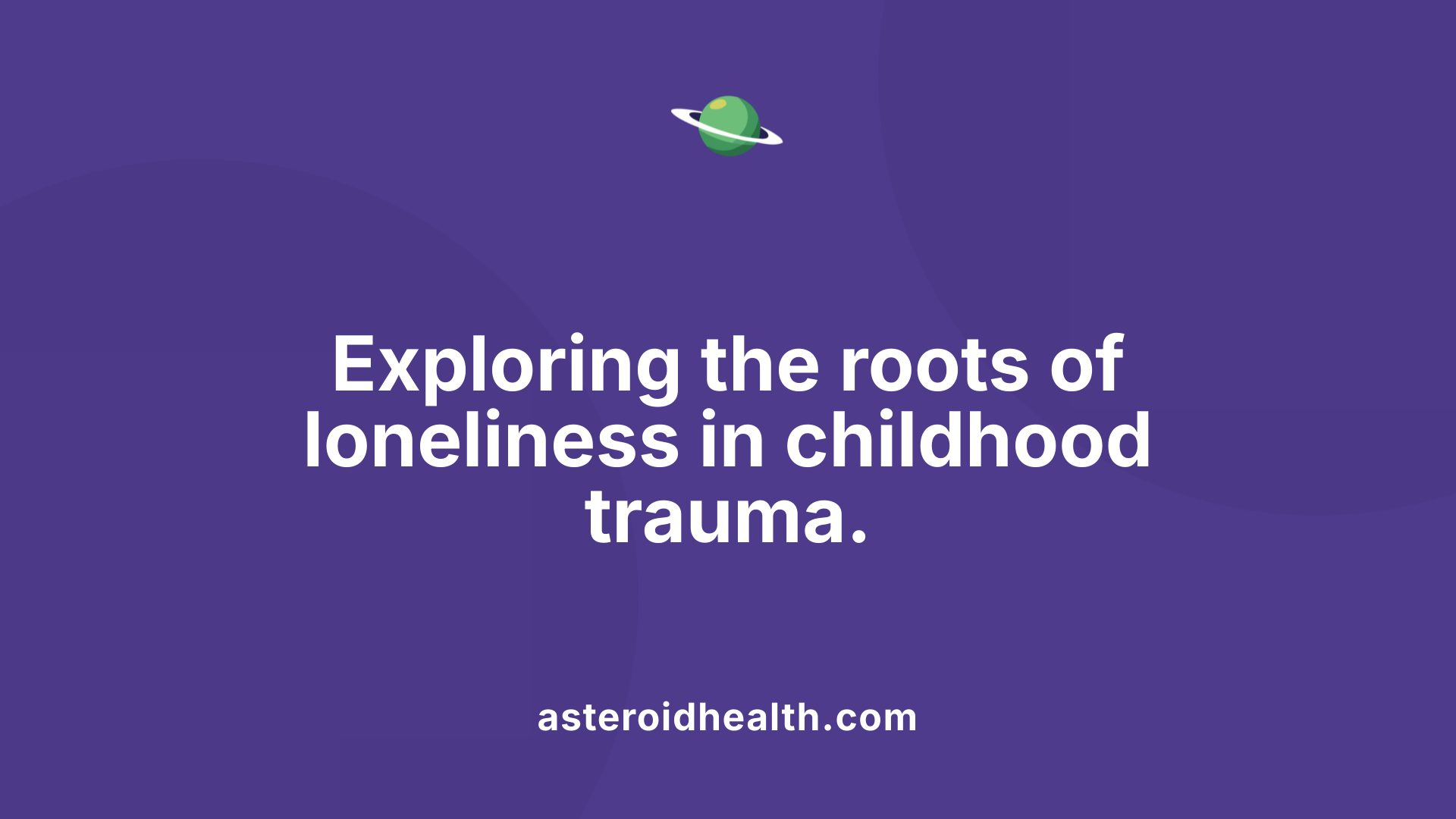
How do early experiences of trauma affect loneliness in individuals with personality disorders?
Early trauma experiences significantly influence loneliness in individuals diagnosed with personality disorders. The evidence indicates that familial alienation and emotional abuse during childhood contribute to enduring feelings of disconnection in adulthood. Such experiences often establish a pattern where the individual exhibits an intense desire for social closeness but simultaneously grapples with overwhelming fears of intimacy and rejection.
Rejection sensitivity becomes paramount in this context. Many individuals with personality disorders exhibit heightened levels of rejection sensitivity—a tendency to experience intense emotional responses to perceived or actual rejection. This sensitivity can be traced back to early childhood interactions marked by inconsistency or neglect, leading to ongoing struggles with trust and connection in later relationships.
Moreover, the impact of emotional abuse during formative years cannot be overstated. It establishes a valuation of self that often stays diminished into adulthood, fostering chronic feelings of inadequacy that heighten loneliness. Individuals from abusive backgrounds may internalize their trauma, believing they are unworthy of connection, which compounds feelings of isolation.
The interplay between loneliness and personality disorder symptoms is critical. As loneliness intensifies, it can exacerbate the severity of the disorder itself. This cyclical relationship can result in impaired self and interpersonal functioning, spiraling further into social withdrawal.
To combat such loneliness, psychological interventions that enhance social skills and rebuild self-esteem are vital. Cognitive-affective biases, including negative thought patterns stemming from past traumas, can be addressed through therapeutic approaches. Recognizing and altering these thought processes can be crucial in reducing feelings of loneliness, ultimately guiding individuals toward healthier social interactions and improved mental health outcomes.
Therefore, it becomes essential to create tailored interventions that focus on these underlying issues, particularly for those suffering from personality disorders. By addressing the roots of loneliness, stemming from childhood trauma, recovery can be facilitated, promoting stronger social connections and a better quality of life.
Effective Coping Strategies and Treatments
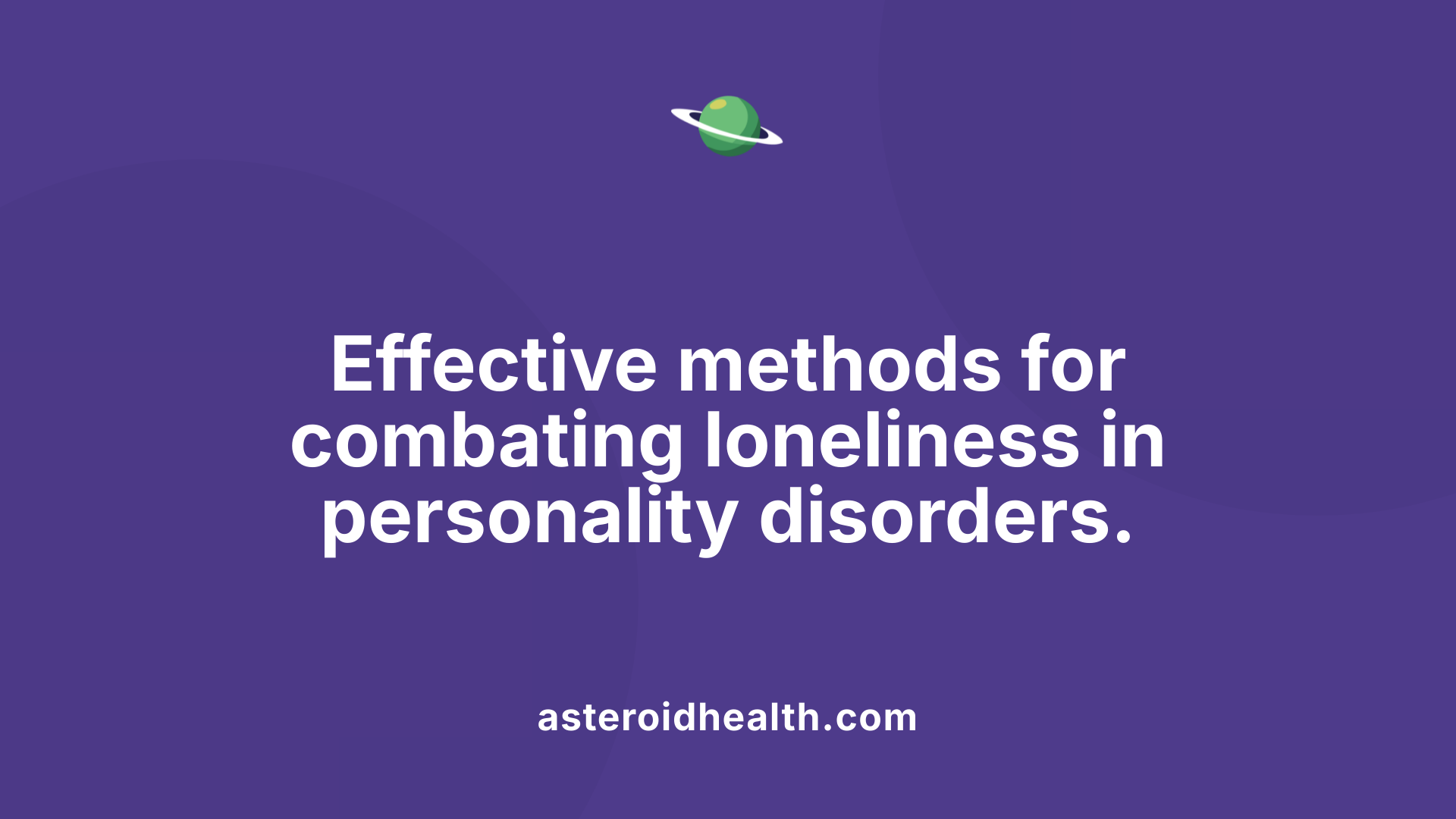
What coping strategies and treatments are available for loneliness in personality disorders?
Coping strategies and treatments for loneliness in individuals with personality disorders incorporate various therapeutic approaches. Cognitive-Behavioral Therapy (CBT) is frequently used to help patients address negative thought patterns and beliefs that contribute to feelings of loneliness. CBT focuses on enhancing social skills and building more positive social interactions, aimed at reducing isolation and improving relationships.
Group therapy has also demonstrated effectiveness in alleviating feelings of loneliness. By providing a supportive environment with peers who share similar experiences, group therapy can foster a sense of belonging. Participants often find comfort and connection through shared narratives of suffering and recovery.
Another important avenue is strengthening social support networks. Interventions that promote community engagement and foster mentorship or befriending relationships can significantly assist in reducing feelings of isolation while enhancing emotional well-being.
Additionally, mindfulness strategies, such as loving-kindness meditation, can cultivate self-compassion and encourage individuals to reach out and connect with others. Regular practice can help individuals with personality disorders better manage emotional distress and build openness toward social interactions.
Overview of Treatments for Loneliness in Personality Disorders
| Treatment Type | Description | Targeted Outcomes |
|---|---|---|
| Cognitive-Behavioral Therapy | Addresses negative thought patterns and develops social skills to reduce feelings of loneliness and improve relationships. | Improved social interactions |
| Group Therapy | Provides a supportive environment for peer sharing, fostering connections and a sense of belonging. | Alleviated feelings of isolation |
| Social Support Networks | Engages participants in community activities and pairs them with mentors to build supportive relationships that combat loneliness. | Strengthened emotional well-being |
| Mindfulness | Employs techniques like meditation to cultivate self-compassion and promote openness to social interactions to mitigate loneliness. | Enhanced emotional resilience |
Combining these treatments against loneliness helps augment recovery efforts in individuals with personality disorders, thereby enhancing their overall mental health and well-being.
Psychological Mechanisms of Isolation
What psychological mechanisms contribute to social isolation in people with personality disorders?
Individuals with personality disorders often navigate a series of complex psychological mechanisms that contribute to their social isolation. One major factor is identity disturbance, a hallmark of many personality disorders, where individuals struggle to establish a stable sense of self. This instability can impede their ability to relate to others authentically, fostering intense feelings of loneliness.
Rejection sensitivity also plays a critical role. Individuals with disorders such as Avoidant Personality Disorder often harbor an acute fear of rejection, leading them to withdraw from potential social interactions. This avoidance can cascade into chronic feelings of inadequacy and social withdrawal, where the desire for connection conflicts with overwhelming fears of intimacy and rejection.
Two key terms often discussed in this context are ego-dystonic and ego-syntonic perspectives. Ego-dystonic isolation describes individuals who feel distressed about their social separation and actively want to escape it; this is common among those with BPD or Avoidant Personality Disorder. In contrast, ego-syntonic isolation refers to individuals who perceive their solitude as normal, often stemming from disorders like Schizoid Personality Disorder. They might feel little concern over their social disengagement, interpreting their aloofness as comfort with solitude rather than a sign of distress.
Consequences and Interventions
These psychological mechanisms interact intricately with an individual's history, often influenced by childhood maltreatment, resulting in deep-rooted feelings of disconnection that persist into adulthood. The emotional instability often associated with personality disorders can exacerbate these feelings, creating a cycle of loneliness that worsens mental health outcomes.
Therapies targeting these mechanisms, such as cognitive-behavioral approaches and dialectical behavioral therapy, are vital. They help individuals reframe their thoughts about social connection, manage rejection sensitivity, and stabilize their sense of identity, ultimately working towards breaking the cycle of social isolation. Understanding these underlying psychological factors is crucial for developing effective interventions.
Impact of Avoidant and Borderline Personality Disorder on Social Interactions
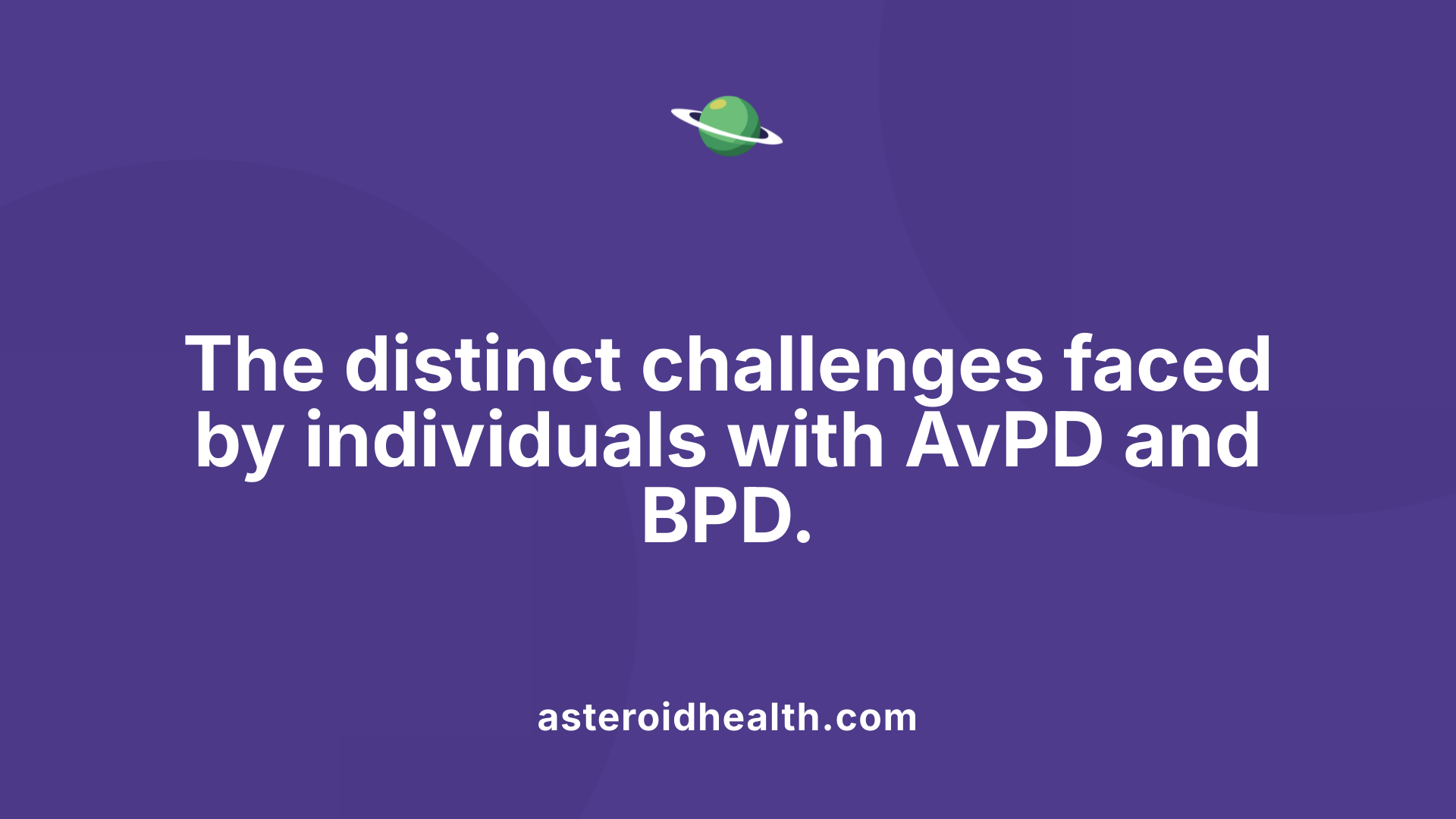
How do Avoidant Personality Disorder and Borderline Personality Disorder impact social interactions?
Avoidant Personality Disorder (AvPD) fundamentally alters the way individuals navigate social environments. Those with AvPD often experience profound shyness and struggle with low self-esteem, perceiving themselves as inadequate. This leads to a pervasive fear of rejection, prompting them to actively avoid social situations. When faced with potential interactions, their intense anxiety can manifest as withdrawal, resulting in solitary and often unfulfilling social experiences. Crucially, individuals with AvPD possess a heightened sensitivity to criticism, which exacerbates their isolation. They may find themselves in a cycle of loneliness, where their longing for connection conflicts with their debilitating fears.
In contrast, Borderline Personality Disorder (BPD) introduces a different set of challenges to social interactions. Individuals with BPD grapple with emotional instability, characterized by rapid fluctuations in mood and intense interpersonal relationships. The fear of abandonment is particularly pronounced; this leads to turbulent and often unstable relationships. Individuals with BPD frequently experience chronic feelings of emptiness, which can incite desperate attempts to maintain closeness with others, sometimes through manipulation or aggressive behaviors. This need for connection, paired with an underlying disconnection from self and others, complicates their social dynamics further.
Both disorders emphasize the importance of tailored therapeutic approaches. Addressing the specific interpersonal challenges faced by individuals with AvPD and BPD is crucial for enhancing their social functioning and overall quality of life. For example:
| Disorder | Key Features | Impact on Social Interaction |
|---|---|---|
| Avoidant | Extreme shyness, low self-esteem, fear of rejection. | Leads to avoidance of social situations, increasing feelings of loneliness and inadequacy. |
| Borderline | Emotional instability, fear of abandonment, chronic emptiness. | Creates unstable relationships and complicated social dynamics, often resulting in manipulation or emotional turmoil. |
In summary, both AvPD and BPD can severely impact the ability to engage in fulfilling social interactions, highlighting a need for effective interventions that focus on rebuilding confidence and emotional regulation.
Research Insights on Loneliness and Social Support in Personality Disorders
What are the findings of recent research on loneliness and perceived social support in personality disorders?
Recent research indicates that individuals with personality disorder traits, particularly those lacking narcissistic characteristics, report significantly elevated levels of loneliness and decreased perceived social support when compared to both the general population and other clinical groups. A systematic review compiling data from 70 studies sheds light on this issue, spotlighting the severe impacts of loneliness on mental health outcomes.
Among these individuals, those diagnosed with Emotionally Unstable Personality Disorder (EUPD), also known as Borderline Personality Disorder (BPD), experience pronounced feelings of loneliness. This disconnect correlates with greater symptom severity, functional impairments, and emotional distress, underlining a direct link between personal relationships and mental health outcomes.
Key Insights from the Systematic Review Findings
The systematic review delved into myriad factors affecting loneliness in personality disorders. It found that:
- Lower perceived social support is associated with exacerbated mental health issues, including mood disorders.
- Past traumas and developmental issues play significant roles in contributing to the loneliness experienced by individuals.
- Lower social functioning can lead to an increase in loneliness levels, highlighting the necessity for targeted interventions to enhance social support systems.
With growing evidence emphasizing these concerns, there is an urgent need for higher-quality longitudinal studies to further explore this complex relationship.
EUPD Insights on Loneliness
The examination of EUPD reveals compelling insights into how loneliness manifests:
- Individuals frequently navigate intense emotions, leading to unstable relationships and heightened feelings of abandonment.
- This disorder is uniquely associated with chronic loneliness, even amidst attempts at social engagement, further complicating interpersonal dynamics.
- Emotional and social deficits in EUPD patients often result in diminished needs for social connection, yet they still grapple with feelings of isolation.
In conclusion, the intersection of loneliness and social support in individuals with personality disorders casts light on critical areas for therapeutic intervention. By improving social support structures and addressing past traumas, we can potentially alleviate some of the pervasive loneliness that characterizes these conditions.
Exploring Genetic Correlations
Are there any genetic correlations between loneliness and personality disorders?
Research indicates notable genetic links between loneliness and personality disorders, particularly with Borderline Personality Disorder (BPD). A significant finding from the study is the genetic correlation of rg = 0.23 between Genome-Wide Association Study (GWAS) results for loneliness and BPD. This reveals that individuals with BPD may share underlying genetic vulnerabilities that predispose them to both loneliness and the characteristics of their disorder.
In fact, BPD patients often report higher levels of self-reported loneliness, and higher polygenic scores for loneliness are directly associated with the BPD case-control status. This suggests that genetic factors contributing to loneliness are also influencing the prevalence of BPD.
What do polygenic scores indicate?
Polygenic scores related to loneliness denote cumulative effects of various genetic variants. For individuals with BPD, elevated polygenic scores suggest a significant predisposition toward experiencing heightened feelings of loneliness. This finding underscores that genetic components play a crucial role in the interpersonal challenges faced by those with BPD.
Do loneliness and personality traits share genetic predispositions?
The interplay of loneliness and personality traits further illustrates the genetic dimension of these experiences. Loneliness has been found to have heritable traits linked to personality, particularly showcasing a remarkable genetic correlation with neuroticism (rg = 0.71). This suggest that those prone to neuroticism may be more susceptible to feelings of loneliness.
Conversely, negative correlations with traits such as agreeableness and extraversion reveal that individuals high in these positive traits experience lower levels of loneliness. This complex relationship suggests that while genetic factors contribute to the risk of loneliness, environmental influences—such as childhood experiences—also play a significant role, creating a multi-faceted landscape of mental health issues related to personality disorders.
| Genetic Factor | Correlation to Loneliness | Associated Personality Disorder |
|---|---|---|
| GWAS Results | rg = 0.23 | Borderline Personality Disorder |
| Polygenic Scores | Higher scores correlate with increased reported loneliness | BPD |
| Neuroticism | rg = 0.71 | Emotionally Unstable Traits |
| Agreeableness & Extraversion | Negative correlation | Avoidance of Loneliness |
This comprehensive overview emphasizes that both genetic and environmental factors must be considered in understanding the experiences of loneliness and the nuances of personality disorders.
Practical Solutions for Reducing Isolation
What practical advice can help reduce social isolation for those with personality disorders?
Reducing social isolation among individuals with personality disorders can be approached through various practical strategies that promote connection and engagement in meaningful activities. Encouraging participation in hobbies or interests can be a great starting point. Activities that inspire creativity or physical engagement, such as art classes, exercise groups, or book clubs, enable individuals to interact with others in a shared environment, creating opportunities for socialization.
Using technology effectively is also vital. Staying in touch with friends and family through communication platforms like video calls or social media can help maintain those critical connections, especially for those who may struggle with face-to-face interactions. Regular check-ins, whether through texts or calls, can make a significant difference for individuals feeling isolated.
Group therapy is another excellent option, offering a controlled environment where people can share their experiences and support each other. Therapeutic programs that focus on skills development, such as cognitive-behavioral therapy (CBT), can also help individuals reframe negative thoughts and address feelings of low self-worth—common precursors to loneliness. These sessions often lead to improved social skills and can significantly enhance one’s ability to form and maintain relationships.
Engaging in volunteer work can provide a profound sense of purpose and community connection. Helping others not only benefits the recipient but also enriches the volunteer's life, countering feelings of isolation. Volunteering fosters a sense of belonging and creates pathways for new friendships.
Exploring structured living arrangements, such as cohousing communities, can create a supportive environment where individuals can engage with others regularly. These arrangements often encourage collaboration and communal activities, fostering natural connections and reducing feelings of isolation.
Implementing these strategies could significantly improve social engagement and emotional wellbeing for those grappling with personality disorders.
Overcoming Challenges of Isolation
What challenges do individuals with personality disorders face due to isolation?
Isolation presents serious challenges for individuals diagnosed with personality disorders, manifesting in multiple dimensions of their experiences. The emotional distress stemming from loneliness can be profound. Many individuals report escalating feelings of emptiness, anxiety, and even depression, often linked to their struggles with interpersonal connections. This loneliness frequently correlates with the severity of their symptoms, establishing a cycle that complicates recovery.
Emotional Distress
Stripped of meaningful relationships, those with personality disorders may exhibit heightened rejection sensitivity, leading to an overwhelming fear of abandonment. In cases like Borderline Personality Disorder (BPD), this can result in conflicting desires for closeness, juxtaposed with fears that drive further isolation. Chronic feelings of worthlessness can also intensify the emotional tumult that accompanies their social withdrawal.
Physiological Effects
The physiological effects of isolation are equally concerning. Chronic loneliness has been shown to activate the hypothalamic-pituitary-adrenal (HPA) axis, causing increased stress hormone production. This state of heightened stress can contribute to various health issues, including cardiovascular problems and weakened immune response, making individuals more vulnerable to mental and physical health disorders.
Social Exclusion
Social exclusion compounds these effects. Individuals with personality disorders may frequently face discrimination, further alienating them from potential support networks. This marginalization fosters feelings of inadequacy and shame, reinforcing their isolation. The interplay between social withdrawal and a lack of perceived social support diminishes their ability to cultivate relationships, exacerbating both loneliness and emotional distress.
Improving mental health outcomes for these individuals involves targeted interventions that aim to reduce isolation and bolster social support. Treatments such as group therapy can offer shared experiences, providing an opportunity to foster connections and alleviate loneliness. Ultimately, addressing both the emotional and physical consequences of isolation is critical in the journey toward recovery.
Insights from Recent Research
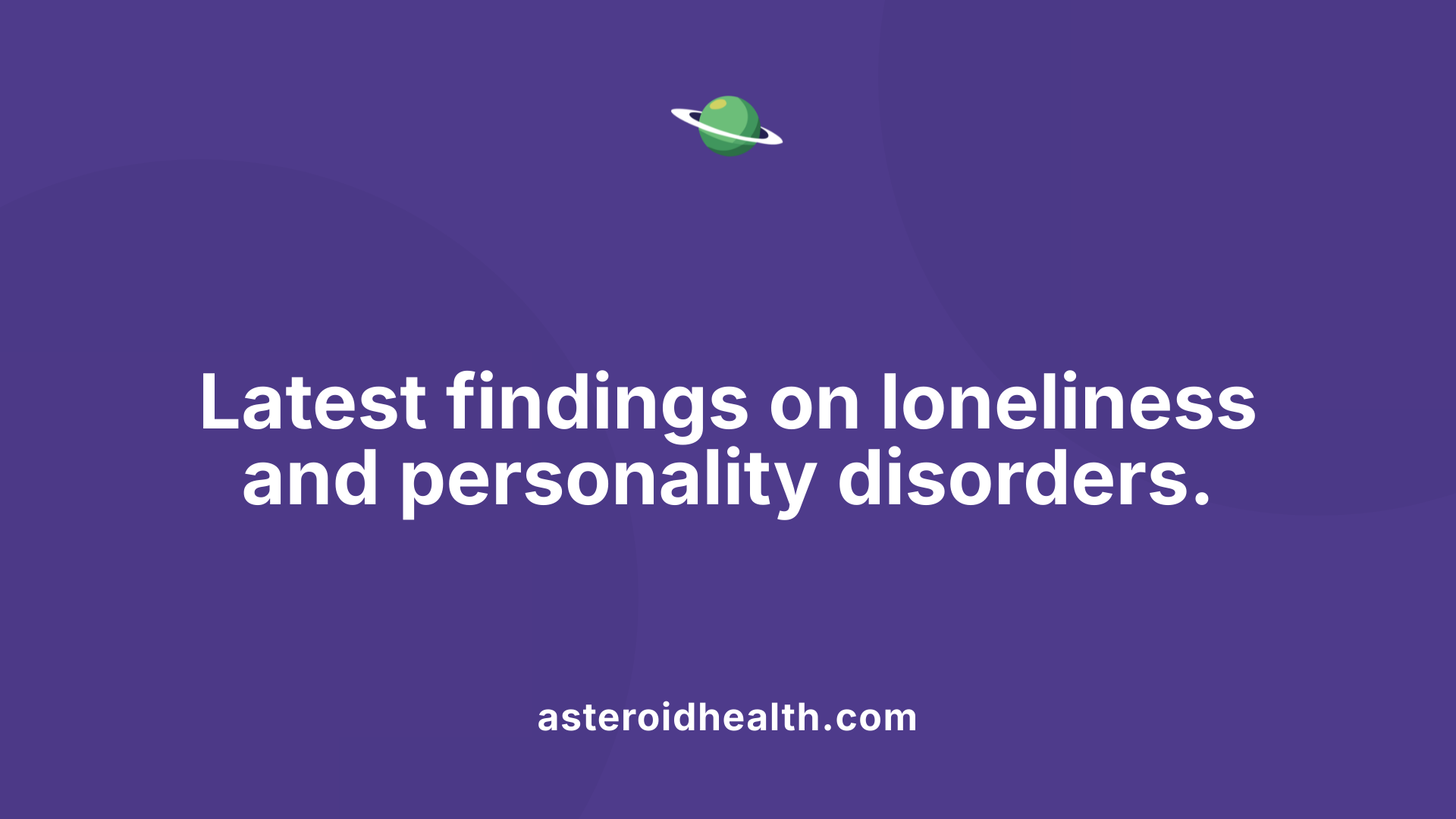
What recent academic and clinical research insights are available on loneliness and personality disorders?
Recent academic and clinical research has shed light on the intricate relationship between loneliness and personality disorders. Studies indicate that loneliness is prevalent among individuals with personality disorders, impacting their mental health and recovery profoundly. Research has highlighted that individuals with certain personality disorder traits experience significantly elevated levels of loneliness and low perceived social support compared to the general population.
A systematic review synthesizing data from 70 studies emphasizes the importance of understanding how loneliness manifests in different personality disorders. For instance, individuals with borderline personality disorder (BPD) often navigate chronic feelings of emptiness and social isolation despite a strong desire for connection. Such loneliness not only tends to exacerbate existing mental health symptoms but can also hinder recovery pathways.
Interestingly, the prevailing themes from this research point to how early childhood experiences, such as emotional abuse and neglect, contribute to these patterns of loneliness and social withdrawal in adulthood. These factors suggest that personalized interventions targeting these early experiences could be pivotal in treatment approaches.
How are therapeutic approaches evolving in response to findings on loneliness?
In light of these findings, therapeutic approaches are evolving to incorporate targeted strategies for addressing loneliness within treatment. Group therapy has shown potential for alleviating feelings of isolation by fostering a sense of belonging among peers. However, outcomes can vary significantly; thus, it's essential that clinicians remain sensitive to each patient's unique experiences with loneliness.
Further, established therapies like Dialectical Behavioral Therapy (DBT) are beginning to incorporate elements specifically aimed at enhancing social connectedness and managing interpersonal dynamics. This integration is vital as it reflects an understanding that tackling loneliness directly can improve treatment efficacy and reduce instances of maladaptive coping behaviors like self-harm.
What research methodologies are pivotal in studying loneliness and personality disorders?
A combination of qualitative and quantitative research methodologies is fundamental in studying loneliness and personality disorders. This includes cross-sectional surveys for assessing prevalence rates and longitudinal studies to track changes over time. Utilizing digital health technologies enables researchers to engage a wider array of participants, which adds depth to the understanding of loneliness across demographic spectrums.
As research continues, employing mixed-methods designs that integrate patient narratives with statistical analyses can enhance the evidence base. Such approaches will help streamline interventions aimed at mitigating loneliness by deeply understanding the impacts of personality disorders on social functioning.
In conclusion, the dynamic interplay between loneliness and personality disorders necessitates ongoing research and innovative treatment paradigms that focus specifically on enhancing social connections and emotional support for affected individuals.
Conclusion
Understanding the profound impact of social isolation on individuals with personality disorders is essential to advancing mental health treatment and support. By addressing the complex interplay of psychological mechanisms, genetic predispositions, and early trauma, practitioners can foster more effective interventions. Moreover, placing emphasis on enhancing social support and reducing loneliness through therapy, community engagement, and innovative research approaches can significantly improve quality of life and aid recovery. As awareness and insights into this critical issue continue to evolve, professionals and communities alike must collaborate to break the barriers of isolation and nurture compassionate environments for healing.
References
- The experience of loneliness among people with a “personality ...
- Psychopathology of social isolation - PMC
- Loneliness Linked to Personality Disorders - Neuroscience News
- Borderline Personality Disorder, Self-Isolation, and Loneliness
- Loneliness, Social Isolation and Their Difference: A Cross ... - Frontiers
- Personality Disorders | Johns Hopkins Medicine
- Avoidant Personality Disorder: Symptoms & Treatment
- Personality disorders - Symptoms and causes - Mayo Clinic
- The prevalence and severity of loneliness and deficits in perceived ...
- Borderline Personality Disorder and Loneliness: How Residential ...
Recent articles

OCD Recovery and Staying Resilient Against Triggers

Natural Remedies for Managing Anxiety

Mindfulness Meditation to Reduce OCD Triggers

How Social Media Affects Mental Health

Personality Disorders and Identity Issues

Exercise As a Tool for Mood Enhancement

How a General Outpatient Program Supports Long-Term Recovery

Excoriation Disorder: Why Skin Picking Happens

The Role of Spirituality in Mental Health Recovery

The Role of Storytelling in Processing Trauma

Cognitive Behavioral Therapy for Anxiety and Depression

Family Interventions for Schizophrenia and Related Disorders

How to Support a Friend with Mental Health Issues

How to Manage Mental Health During Medication Adjustments

The Impact of Sleep Deprivation on Mental Health

Staying on Track Post-OCD Treatment

Understanding Eating Disorders: Types and Symptoms

How to Support a Loved One with a Mental Health Condition

How to Practice Mindful Eating

How to Stay Motivated in a General Outpatient Program

Techniques for Grounding During Emotional Storms

How a general outpatient program encourages community support in recovery

How to Know When It’s Time to Change Medications

Family Therapy to Address OCD-Related Issues

The Mental Health Benefits of Community Involvement

The Impact of Workplace Culture on Mental Health

The Importance of Routine in Managing Mental Health

How therapy improves communication skills and relationships

Orthorexia: When Healthy Eating Becomes an Obsession

How to Work with Your Doctor to Find the Best Medication Plan

How cognitive-behavioral therapy helps in mental health therapy sessions

How Financial Stress Impacts Mental Health

Histrionic Personality Disorder: The Need for Attention

Medication management: the importance of working closely with your provider

How Exercise Boosts Mental Health

Medication management: transitioning between medications safely

The structure of psychiatric day treatment programs and their benefits

Recognizing Emotional Patterns in Seasonal Changes

Moral Dilemmas in Religious Scrupulosity

How Pets Can Improve Mental Health

The Role of Neurotransmitters in Depression

Understanding and Managing Anger Issues

Hoarding Disorder: When Clutter Takes Over

Cognitive Remediation Therapy in Schizophrenia

Social Isolation in Personality Disorders

Hoarding Disorder: When Clutter Takes Over

Hair-Pulling Disorder: Understanding Triggers

How to Balance Medication and Therapy for Mental Health Treatment

The Role of Exercise in Managing Anxiety

The Impact of Chronic Illness on Mental Health

The Role of Cognitive Behavioral Therapy in Psychiatric Day Treatment

Psychiatric day treatment for individuals facing legal issues related to mental health

The Role of Compassion in Mental Health Care

Psychiatric day treatment for individuals with autism spectrum disorders

The benefits of psychiatric day treatment for mental health recovery

How therapy helps individuals discover their personal strengths

How general outpatient programs create a support network for recovery

The Link Between Self-Care and Successful Psychiatric Treatment

The Benefits and Risks of Psychiatric Medications

How to Manage Anxiety About Starting a New Treatment Program

Managing Depression Through Psychiatric Day Treatment

The Future of Psychiatric Medication: What’s Next in Mental Health Treatment

The Impact of Loneliness on Mental Health

Medication management tips for individuals with bipolar disorder

How to Identify and Manage Mental Health Relapses

How to Know If Your Psychiatric Medication Is Working

The Connection Between Medication Management and Psychiatric Day Treatment

Can You Stop Taking Psychiatric Medications? What You Need to Know

How to Choose Between Inpatient, Outpatient, and Day Treatment Programs

How to Know If You Need a General Outpatient Program or More Intensive Care

How Long Does It Take for Psychiatric Medications to Work?

How a General Outpatient Program Differs from Intensive Outpatient Therapy

How to Address Mental Health Concerns in First Responders

How to Address Mental Health Concerns in Underserved Communities

How to Know If You Need a Psychiatric Medication Evaluation

Common Myths About Psychiatric Medication Management

The Role of Therapy in General Outpatient Programs

The Role of Psychiatric Medication in Mental Health Treatment

The Benefits of Psychiatric Day Treatment vs. Inpatient Care

How Insurance Covers General Outpatient Programs

The Importance of Routine in Psychiatric Day Treatment Programs

How Psychiatric Day Treatment Helps Prevent Hospitalization

Can Telehealth Be Used for Psychiatric Day Treatment?

Managing Medication for Co-Occurring Mental Health Conditions

How to Talk to Your Employer About Psychiatric Medication Needs

How to Talk to Family Members About Your Medication Plan

How Family Involvement Supports Psychiatric Day Treatment

How to Manage Stress While in a Psychiatric Treatment Program

How to Prepare for a Psychiatric Medication Appointment

How to Transition Off Psychiatric Medication Safely

How to Stay Committed to Your Mental Health Treatment Plan

How to Talk to Your Psychiatrist About Medication Concerns

The Role of Self-Compassion in Mental Health Recovery

Finding the Right Psychiatric Medication for Your Needs

How to Talk to Your Doctor About Switching Medications

Is Psychiatric Day Treatment Right for You?

Who Can Benefit from a General Outpatient Program?

Can Medication Management Help with PTSD Treatment?

The Connection Between Psychiatric Day Treatment and Medication Management

